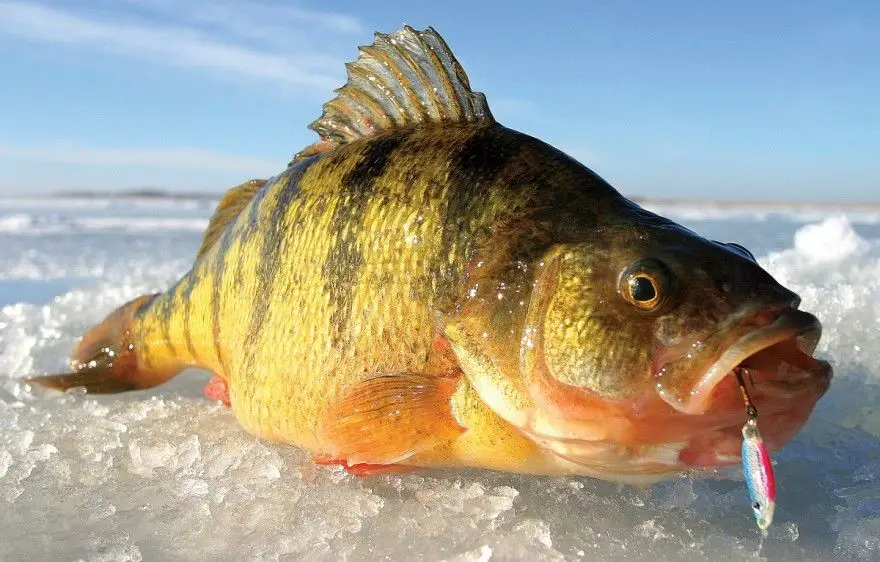Hibernation is a state of minimal activity and metabolic depression in endotherms. We call it sleeping In for the winter, but Hibernation is characterized by low body temperature, slow breathing and heart rate, and low metabolic rate. It most commonly occurs during the long cold winter months. We know Bears do it, Ground Squirrels and Skunks do it too but Do Fish Hibernate In the Winter?
No, most fish don’t hibernate, Instead, they simply school together in deep water pockets where it’s a few degrees warmer & enter a state of rest called torpor that slows their metabolism and functions down to a minimum level, suppressing appetite, & respiration, digestion, & their activity levels.
Most fish like trout and pike and bass are cold-blooded fish which means their body temperature is regulated by their environment. They can adapt to long periods of time in cold winter by turning on their mechanism for survival until the Spring, the warm sun brings nature back to life.
How Do Fish Survive in Cold Water
Fish have several things going for them when the seasons change and the water temperatures change to the cold side. They have a few abilities to survive winter below the ice. Fish are cold-blooded meaning their body temperature matches the environment they are living in.
During Colder temperatures fish have a reduction in their metabolism. Colder water slows their metabolism down and how they process bodily functions like respiration, digestion, and their overall activity level during the winter months as a survival mechanism.
Fish will hunker down together in pockets of slightly warmer water and enter a state of torpor, meaning, a state of decreased activity in an animal, usually by a reduced body temperature and metabolic rate. Torpor enables animals to survive periods of reduced food availability. reducing their respiration and using as little energy as possible.
Torpor is a state which is a lighter, more temporary state than that hibernation, this state only lasts from a few hours to a couple of weeks. In the northern United States, red squirrels and other non-hibernating mammals utilize torpor at night or for several days if the weather is really bad during the winter to conserve as much energy as possible during the coldest period, re-emerging once the sun is up and warmed things up a bit.
The coldwater fish species, such as trout and salmon, will stay a little more active throughout the water column and prey on other organisms for food. These types of fish are caught while Ice Fishing in the bigger and deeper lakes around the Country.
Once the top layer of the water freezes over on a lake, pond, river, or stream it provides some insulation that helps the waterbody retain its heat. Because warm water sinks in very cold fresh water, fish in these water bodies often migrate in groups near the bottom.
Throughout the winter oxygen levels decline as ice forms on the top layers of a lake closing off any atmospheric oxygen levels from getting into the water. It also blocks out sunlight that aquatic plants and phytoplankton need to produce oxygen within the lake. Most aquatic plants die, but their root systems remain intact and store energy to produce new vegetation in the spring.
There is some phytoplankton that is able to survive with the little bit of light that makes it through the ice and snow. Many amphibians (like frogs and salamanders) will enter a state of hibernation and seek protected areas, often burrowing down into the mud along the lake bottom. In this resting state, fishes’ hearts slow down, their needs for food and oxygen decrease, and they move about very little.
If you have ever been ice fishing, you know that a long line, a slow, colorful lure, and a hearty portion of patience are often required besides some warm clothing to land these Popular ice-fishing species include walleye, northern pike, yellow perch, and rainbow trout still are biting just not in a frenzy like in-between seasons.
What do Fish Eat in the Winter
The cooler water in the winter months slows their metabolism considerably, which is why we can usually find fish hanging out in slower-moving currents or deep pools. Even though their slow metabolisms make it so they can eat less, that doesn’t mean that fish in cold water doesn’t need to eat food at all. Once the water temperature reaches the upper 40s, things start to rapidly slow down for them and all aquatic. During the state of torpor, the fish’s body releases hormones that suppress the appetite and conserve energy, while also decreasing protein synthesis and tissue growth.
As a result, fish require far less caloric intake to survive throughout the winter. However, the fish do not hibernate; they are still feeding, just at a reduced rate compared to the warmer seasons when they need a greater caloric intake in response to a higher metabolism.
Speaking as an Angler, and an Ice Fishing enthusiast, there is good news and bad news. While this does make lake fish in the winter slightly slower and fish more difficult to catch, winter lake fishing can provide great fishing opportunities if you know where to look. It’s about location.
With this slowing of the metabolism, fish like bass will metabolize food more slowly, lessening their need to feed as much. The fish in the winter will simply feed less. But no matter where the fish are, some of them will be engaged in feeding behavior differently and normally less successful than they would be during warmer times of the year.
Normal lake fish like Crappies, Bluegills, and Perch must modify their intake and adjust to the environment to survive. If you are hardcore anglers you’ll need to adjust what bait you are using to meet what’s natural for these species of fish. Bloodworms or midge larvae – also known as Chironomidae – are one of the commonest forms. As the immature stage of short-lived winged insects, bloodworms live on and in the bottoms of lakes, streams, and rivers. Grubs dwell in tiny burrows in soft or “sticky bottomed” areas, such as clay or marl in the bottom of a lake or stream.
Do Fish Hibernate Or Migrate
During the winter months of the year, fish like bass seeks out the warmer water, though they may not confine all of their activities such as feeding to these areas. Most fish slow down and hibernate in the warmer spots of a big lake. All it takes is a one to two-degree temperature increase to congregate large numbers of fish to a popular spot in a huge Lake or part of the Ocean.
Most fish Migrate throughout the lake to find these spots together that are slightly warmer pockets near the bottom and stay put for the cold winter months. Some species, like koi and gobies, may burrow into soft sediments at the bottom and go dormant like frogs and other amphibians, but most fish simply school in the deepest pools of a body of water and take a “winter rest.”
- In rivers, bass will migrate to a sheltered bay to avoid moving water that tends to be colder to try and stay warmer
- In lakes, fish will move to deeper portions of the lake where, at times, large groups of fish will congregate together in the same pockets.
In the summer months, a deep lake is stratified with layers of warmer water temperatures on top and cooler waters in layers underneath. In the winter months, the opposite is true. Many types of fish migrate on a regular basis, on time scales ranging from daily to annually or longer, and over distances ranging from a few meters to thousands of kilometers. Fish usually migrate to feed or to reproduce, but in other cases the reasons are unclear.
Migrations involve movements of the fish on a larger scale and duration than those arising during normal daily activities. Some particular types of migration are anadromous, in which adult fish live in the sea and migrate into freshwater to spawn, and catadromous, in which adult fish live in freshwater and migrate into saltwater to spawn.
- Anadromous(fish migrating from salt water to spawn in freshwater) Salmon and striped bass are well-known species of migratory fish that go through this process.
- Catadromous (fish spend most of their lives in freshwater then migrate to the sea to breed). Catadromous fish are born in saltwater, then migrate into freshwater as juveniles where they grow into adults before migrating back into the ocean to spawn. Examples: American eel, European eel, inanga, shortfin eel, longfin eel.
Fish will actually lie in the mud to stay warm during the winter, so don’t be surprised if you catch a fish that has mud on its belly. In a similar manner, groups of fish will suspend or hold tight to cover objects that can radiate heat such as dock floats, rock banks, standing timber/stumps, or laydowns. Habitat that extends above the surface allows heat from the sun to be radiated from above down below into the water.
What are Bottom Feeder Fish
For more great information on Fish and anything Water stay right here at MyWaterEarth&Sky-Naturally occurring bottom-dwelling fish can help maintain freshwater or saltwater waters by absorbing carbon dioxide, improving the water quality by constantly stirring up bottom sediment, eating aquatic organisms, and some………………. Continue reading
JimGalloway Author/Editor
References:
Ausable River Association-A Look Under the Ice
Conservation Institute-Animals that Hibernate


